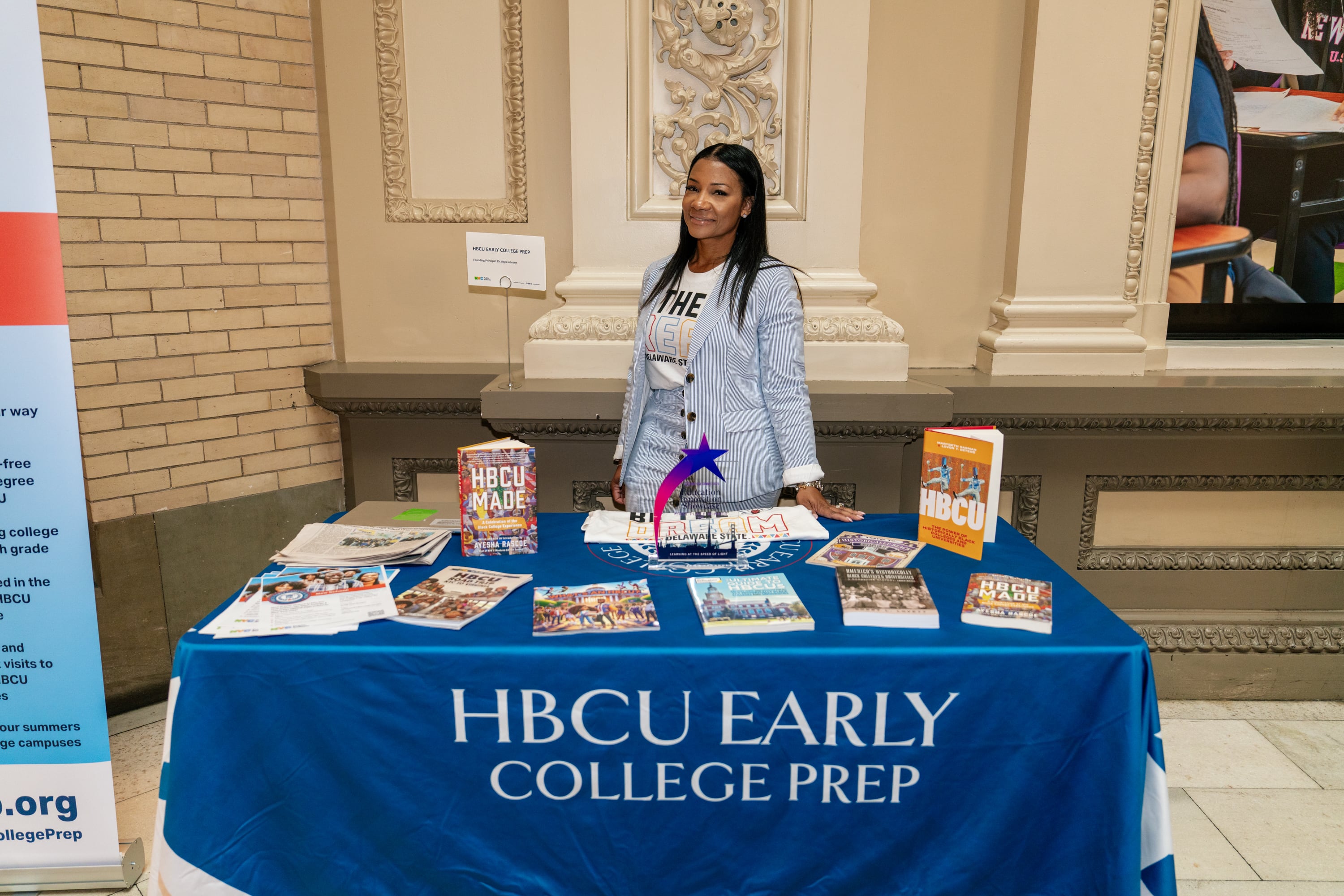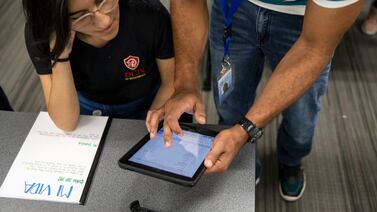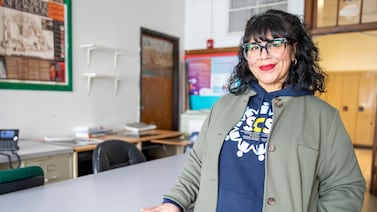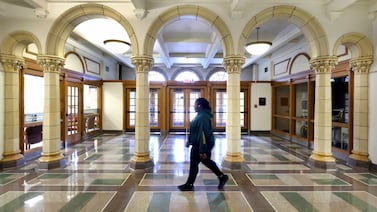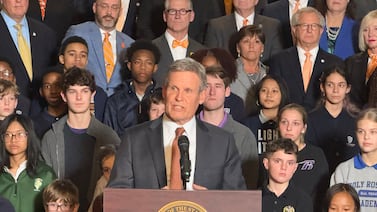Sign up for Chalkbeat New York’s free daily newsletter to get essential news about NYC’s public schools delivered to your inbox.
A new literacy-focused academy in central Brooklyn to help struggling readers. A health care-focused high school partnering with a hospital system in Queens. The city’s first-ever high school to offer early college classes through a historically Black institution.
Those are among the seven new public schools slated to open next year in New York City, part of a multiyear flurry of openings that city officials hope will reinvigorate the system at a time of faltering enrollment.
“Our new school strategy is designed to directly address that challenge,” Education Department First Deputy Chancellor Dan Weisberg told reporters Monday at the Education Department’s downtown headquarters kickoff event. “This is really trying to be responsive to community need.”
The principals set up display tables stocked with flyers and trinkets related to their school’s specialties, which reflect some of the city’s biggest education priorities and challenges.
The Central Brooklyn Literacy Academy in Crown Heights is part of a larger push to revamp the way city public schools teach literacy and identify and support students with dyslexia. Several others are designed to equip students with specific skills and credentials to enter the workforce,part of a larger effort to rethink how schools should prepare students for life after graduation. Another geared towards newly arrived immigrants comes on the heels of a historic influx of migrant students whom the city’s education system is still straining to accommodate.
Officials have launched 16 new schools over the past two years — a pace that comes with some risk as the city is still reeling from the loss of roughly 100,000 K-12 students since the 2019-2020 school year. Many schools are struggling to sustain enough enrollment to even stay viable.
But officials say the new schools can boost enrollment citywide by attracting families who may have otherwise left the system.
“We are bringing students back into the New York City public school system,” said Asya Johnson, the principal of HBCU Early College Prep, set to open in Southeast Queens in the fall. “There are students who applied from Catholic schools, private schools, and parochial schools … We are a direct indication of what’s possible.”
Here are the schools set to open next year and how they fit into the city’s educational landscape:
Bronx STEAM Center:
Based on the Brooklyn program with the same name, the Bronx STEAM Center offers 11th and 12th graders at 10 partner schools specialized training in careers like health care and cybersecurity. Students will split their time between their home school and the Bronx STEAM center, which is equipped with specialized facilities and staff.
Students apply to the program in 10th grade and must be enrolled in “accelerated coursework” at their current school. Buses will shuttle students between their home school and the Bronx STEAM Center, and students will receive diplomas from both schools, said principal Maha Hasen.
Central Brooklyn Literacy Academy:
The bumpy road to opening the Central Brooklyn Literacy Academy showcases both the promise and pitfalls of the city’s new school efforts. To secure space for the literacy academy, city officials proposed closing M.S. 394, a shrinking traditional public school in Crown Heights, sparking intense pushback from that school’s families and educators that delayed the approval process by several months.
But supporters of the Literacy Academy, which offers specialized instruction for students lagging several grades behind in reading, say it’s sorely needed. The academy, modeled on a similar program that launched two years ago in the South Bronx, is an effort to offer the kind of tailored literacy instruction that has often historically been confined to private schools disproportionately accessible to wealthier families.
As part of the compromise that led to the school’s approval, Education Department officials agreed to give priority at the Literacy Academy to students from M.S. 394 as well as those from several surrounding districts. Students do not need to have a learning disability to enroll — and 60% don’t — said parent leader Naomi Peña.
Principal Jason Borges acknowledged that the rocky approval process has been a challenge, but said the school is working hard to recruit and staff up by this fall.
“It’s all cylinders at once,” he said.
HBCU Early College Prep High School:
The first-of-its-kind school in southeast Queens is among a growing number of early college programs that allows students to earn college credits and leave high school with an associate degree. The school will partner with Delaware State, a historically Black college, and expose students to the “rich traditions of an HBCU” by matching them with faculty mentors and setting up frequent visits, according to the school’s flyer.
The school, which admitted roughly 100 students to its inaugural class, screens applicants based on their middle school grades, two essay questions, and a video. The school is part of an effort by former schools Chancellor David Banks to open more “academically accelerated” schools in historically underserved neighborhoods. The school got roughly 1,000 applications for its inaugural class, Johnson said.
“The Southeast Queens community demanded to have a school like this, and they deserve it,” she said.
Middle School of Innovation:
The Middle School of Innovation will focus on technology and weave artificial intelligence into its curriculum, said principal Eileen Herusso, whose display table featured a virtual reality headset, turntable, and video game consoles.
Herusso said the middle school, located in Brooklyn’s chronically overcrowded District 21, will bring some of the specialized technology usually found in high schools to a younger crowd.
Banks, despite initial skepticism, became a vocal supporter of exploring the application of artificial intelligence in schools, teasing a sweeping plan that has yet to come to fruition.
Northwell School of Health Sciences:
City officials have been promoting the opening of the Northwell School of Health Sciences for more than a year.
Located in a gleaming new facility in Woodside, Queens, the school is supported by a $25 million startup grant from Bloomberg Philanthropies to launch what officials say is a pathbreaking partnership between a city public high school and a major health care system.
Students can graduate with credentials that allow them to start work right after high school in roles like medical assistant, but many will also go on to college and higher degrees, said principal Erika Hurtado-Valentino.
Students will also get access to paid internships, and eligible graduates will get guaranteed job interviews at Northwell, school officials said. Banks touted the school as a crown jewel in his efforts to expand career and technical education citywide, efforts his successor, Melissa Aviles-Ramos, has continued.
Admission to the school is unscreened, though students living in Queens get priority. The inaugural class is expected to be between 200 and 225 students.
Queens International High School:
A part of the Internationals Network of public schools geared toward newly arrived immigrants, Queens International High School will be the first such school run from sixth to 12th grade. It’s also the first international middle school in Queens, the borough that’s absorbed the largest share of the roughly 48,000 newcomers who have arrived since summer 2022, according to city officials.
Starting in sixth grade will allow the school to begin work on language acquisition earlier than other international schools and put students in a good position to either continue on at the school in ninth grade or apply to other high schools, said principal Elizabeth Demchak, who previously founded and led Claremont International High School in the Bronx. Students who entered the country in the last five years are eligible to enroll.
The school’s approval wasn’t without friction. Parents from the I.S. 77, located in the same building, protested that opening the new school will strain building resources and draw students away from I.S. 77, which offers a Spanish dual language program.
Staten Island Rise Academy P.S. 89:
A K-8 school for students with autism and other complex disabilities, Staten Island Rise Academy is the first such public school to open in the borough in decades, said principal Denise D’Anna.
The school is a part of the city’s District 75 for schools that serve students with complex disabilities. Officials have pushed to open more District 75 schools in recent years to cut down on the often hours-long school bus commutes students in the district face to get to schools that can meet their needs.
D’Anna, who started her career as a school bus driver, said the new school will “alleviate a lot of the time that our students are sitting on buses and having to travel, making it easier for families to be … a part of the school.”
Michael Elsen-Rooney is a reporter for Chalkbeat New York, covering NYC public schools. Contact Michael at melsen-rooney@chalkbeat.org.

